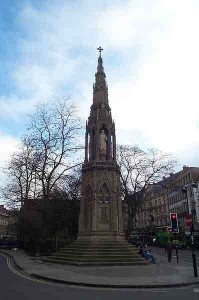 On this day in history, 21st March 1556, Archbishop Thomas Cranmer was burned at the stake in Oxford for heresy. His execution was a despicable act in that it was unlawful because Cranmer had actually recanted five times. He should have been absolved, but he wasn’t.
On this day in history, 21st March 1556, Archbishop Thomas Cranmer was burned at the stake in Oxford for heresy. His execution was a despicable act in that it was unlawful because Cranmer had actually recanted five times. He should have been absolved, but he wasn’t.
On the day of his execution, Cranmer was ordered to make a final public recantation at the University Church Oxford. He agreed, but after praying and exhorting the people to obey the King and Queen, he renounced his recantations and professed his true faith:-
“And now I come to the great thing which so much troubleth my conscience, more than any thing that ever I did or said in my whole life, and that is the setting abroad of a writing contrary to the truth, which now here I renounce and refuse, as things written with my hand contrary to the truth which I thought in my heart, and written for fear of death, and to save my life, if it might be; and that is, all such bills or papers which I have written or signed with my hand since my degradation, wherein I have written many things untrue. And forasmuch as my hand hath offended, writing contrary to my heart, therefore my hand shall first be punished; for when I come to the fire, it shall first be burned.
And as for the Pope, I refuse him as Christ’s enemy, and antichrist, with all his false doctrine. And as for the sacrament, I believe as I have taught in my book against the bishop of Winchester, which my book teacheth so true a doctrine of the sacrament, that it shall stand in the last day before the judgment of God, where the papistical doctrines contrary thereto shall be ashamed to show their face.”
He was quickly dragged out of the pulpit and taken to the stake. Martyrologist John Foxe describes what happened next:-
“With thoughts intent upon a far higher object than the empty threats of man, he reached the spot dyed with the blood of Ridley and Latimer. There he knelt for a short time in earnest devotion, and then arose, that he might undress and prepare for the fire. Two friars who had been parties in prevailing upon him to abjure, now endeavoured to draw him off again from the truth, but he was steadfast and immoveable in what he had just professed, and before publicly taught. A chain was provided to bind him to the stake, and after it had tightly encircled him, fire was put to the fuel, and the flames began soon to ascend. Then were the glorious sentiments of the martyr made manifest;—then it was, that stretching out his right hand, he held it unshrinkingly in the fire till it was burnt to a cinder, even before his body was injured, frequently exclaiming, “This unworthy right hand!” Apparently insensible of pain, with a countenance of venerable resignation, and eyes directed to Him for whose cause he suffered, he continued, like St. Stephen, to say, “Lord Jesus receive my spirit!” till the fury of the flames terminated his powers of utterance and existence. He closed a life of high sublunary elevation, of constant uneasiness, and of glorious martyrdom, on March 21, 1556.”
If you visit Oxford, do visit Martyrs’ Memorial, which you can find outside Balliol College at the intersection of St Giles’, Magdalen Street and Beaumont Street. The memorial commemorates the “Oxford Martrys”: Thomas Cranmer and his friends and colleagues, Nicholas Ridley and Hugh Latimer, who were all burned as heretics in Oxford. If you walk down nearby Broad Street, you will find a cross in the road which marks their execution spot. The inscription on Martyrs’ Memorial reads:-
“To the Glory of God, and in grateful commemoration of His servants, Thomas Cranmer, Nicholas Ridley, Hugh Latimer, Prelates of the Church of England, who near this spot yielded their bodies to be burned, bearing witness to the sacred truths which they had affirmed and maintained against the errors of the Church of Rome, and rejoicing that to them it was given not only to believe in Christ, but also to suffer for His sake; this monument was erected by public subscription in the year of our Lord God, MDCCCXLI.”
You can read more about Thomas Cranmer’s arrest, imprisonment and execution in my article from last year – The Unlawful Execution of Thomas Cranmer – 21 March 1556 – and more about the man himself in my 2 part series – The Life of Archbishop Thomas Cranmer and The Execution of Thomas Cranmer.
Notes and Sources
- Foxe’s Book of Martyrs, p236, Chapter on Archbishop Cranmer
- Wikipedia page on Martyrs’ Memorial, Oxford